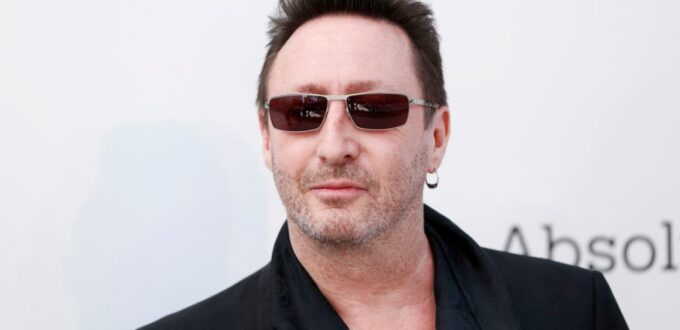Welcome to another installment of PYMNTS’ series on nonfungible tokens (NFTs), the newest craze in cryptocurrency.
In these articles, we are looking at every part of the NFT trend sweeping the worlds of art, video games, social media, fashion and sports.
When it’s finished, you’ll have a solid grasp of the basics of NFTs — what they are, how they work, what they are going to be used for, what their drawbacks are, what you need to be aware — and wary — of, and why people are paying so much money for them.
See also: What Are NFTs and Why Are They Crypto’s Newest ‘Next Big Thing?’
Julian Lennon has turned some memorabilia from his father, John Lennon, and Paul McCartney into NFTs, pitching them to Beatles fans as the opportunity to “own a piece of music history.”
Along with some coats and guitars, you can buy an NFT of some handwritten notes by Paul McCartney for the song “Hey Jude,” which he wrote to console Julian after John Lennon’s divorce. The minimum bid is $30,000, with more than 12 days to go.
That raises a question beginning to gain ground in the market for NFTs — the unique cryptocurrencies that can hold media, such as images, videos or music in a format that is immutable and provably genuine thanks to blockchain technology. What are you actually buying?
And even more importantly when it comes to celebrities — and now sons of celebrities — what are they selling?
One answer is that you get the same thing you get from a physical piece of memorabilia: a connection to something you care about. As the details of the Julian Lennon auction on NFT marketplace YellowHeart put it, you get the opportunity to “share in that exclusivity of Lennon history as the sole owner of the NFT. Starting at $30,000.”
Julian Lennon, it added, remains “the sole owner of the physical item.”
In the case of the Lennon Collection, you are not buying the lyrics but a one-page handwritten note about the instrument arrangement. You can also buy John’s Afghan coat from the Magical Mystery Tour (starting bid $6,000), black cape worn in the movie “Help!” ($8,000) and a trio of guitars Julian Lennon was “gifted” by his father.
Again, you don’t get the actual coats or guitars with your NFT. Nor do you get any rights to the image other than to use and display it personally.
But it is the only NFT of that note that will be created.
It’s kind of the same as the buyer of that NFT of Twitter Founder Jack Dorsey’s first tweet, who got an exclusive and provably authentic image of the tweet — which is still live on Twitter — from more than $2.9 million.
NFTs Blow Up
So, what do you get?
It’s tempting — and at a certain level, quite likely accurate — to say that what you get is a piece of a bubble that will inevitably pop.
You’re talking about a field in which an NFT sale on top-marketplace OpenSea of 1,111 McDonalds job application form NFTs and some snarky comments about working for the fast food giant have seen a sale and resale volume of more than $61,000 at the current price of ether.
The flip side of that is the undeniable place memes have in internet culture — cryptocurrency culture included.
Dogecoin is essentially a meme gone big on the shoulders of crypto industry (and auto industry and space industry) titan Elon Musk, whose tweets of memes featuring the old shiba inu dog meme that is DOGE’s logo have blown the cryptocurrency up from a joke to a top-10 cryptocurrency by market capitalization.
Read also: NFTs Used by Artists to Create Musical ‘Middle Class’
And remember, back in March when she and Musk were still a couple, the musician Grimes sold a collection of NFT artworks for more than $6 million. Now to be fair, she is a successful musician and celeb in her own right.
Still, whether she would have gotten $6 million for her NFTs will forever remain a question mark.
Solid Uses
On the other hand, the success of the booming NFTs market is not limited to a few questionably priced artworks, whether by celebrities or established artists like Mike “Beeple” Winkleman who sold an NFT collage — without any ownership rights — for $69 million.
See also: From Famous Artists to Forgers, the Art World Embraces NFTs
And whatever you think of avatars — including the six- and seven-figure CryptoPunks — they have gained a wide following and have a definite place in the metaverse.
Read more: NFTs Target Collectors Market With Avatars, Celebrities
Then there’s music. While Grimes sold drawings, the band Kings of Leon launched an album purchasable as an NFT, among other formats. While it proved too far ahead of the hype cycle, the use of NFTs as a distribution platform has the potential to rewrite the economics of the music industry in a way that favors the recording artists.
See more: Kings of Leon Changes the Cryptonomics of Music
And, of course, there’s marketing. Many companies are racing to embrace NFTs to catch the metaverse wave.
Read more: Marketing Meets Social Commerce in Metaverse
And whatever shade you want to throw on $60,000 McDonalds NFTs, remember that Ronald McDonald launched an NFT line to hype the 40th anniversary of the restaurant’s occasional but recurrent fan favorite, the McRib sandwich.

No Comments Yet